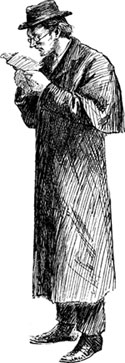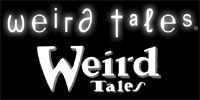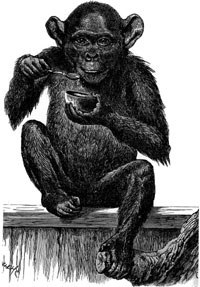Interview with Stephen H. Segal June 7, 2007 – Posted in: Free Content, Interviews, Sybil's Garage
Interview with Stephen H. Segal
by Devin Poore
to the sound of “Greet Death” by Explosions in the Sky…
As published in Sybil’s Garage No. 4

Stephen Segal serves as creative director for the Wildside Press magazine group, including Fantasy Magazine, Weird Tales, and H.P. Lovecraft’s Magazine of Horror. I first met him at ReaderCon in 2005 where he was pitching a new magazine concept titled Earthling. After that, we continued to run into each other at conventions, conferences and readings. Our conversations always revolved around speculative fiction and media, how to get it out to a wider audience, why we would even want to try.
From our first meeting, I realized that someone should be writing down what Stephen had to say. Last year, prior to one of the fall KGB Fantastic Fiction readings in Manhattan, Stephen and I sat down to put this to paper. Incidentally, at the same time, Crispin Glover was being interviewed on a door stoop across the street. Stephen and I have yet to decide if that was a good or bad omen.
To start off on a less than serious note, an employee under the Wildside banner wanted me to ask you why you decided to give up the motion picture martial arts career. Along those lines, do you have many OFFICE SPACE, Michael Bolton-type moments with your name, even though you do pronounce your last name differently?
It’s funny — the bad jokes had finally tapered off a few years ago, and then, inexplicably, they came back worse than ever, despite the fact that Steven (spelled differently) Seagal (spelled differently) hasn’t actually been making any new movies. Yes, it’s a rare week when some bank teller, checkout clerk, or peruser of my business card isn’t moved to laughter by my name. I’ve long since grown past being irritated by it, though — hey, if something as simple as that can brighten someone’s day, far be it from me to rain on their parade.
I should point out that there’s also a Steven T. Seagle who writes some terrific comic books, and I’m occasionally asked more seriously if that’s me. Nope! I am Stephen Harry Segal, the Atlantic City kid turned Pittsburgh journalist turned speculative-arts creative director.
First real question: you started out as an Arts and Entertainment editor in Pittsburgh, which is a far cry from working at Wildside Press as manager and creative director. Or is it? While in Pittsburgh, how much of your job dealt with entertainment of a speculative nature? And if the job itself did not deal with it, were you able to turn it in that direction at all? And how much of that experience with the “regular” entertainment scene can you bring into play with your new position at Wildside?
 I’ve thought about this a lot, because I’ve noticed how many of the most interesting sf authors today are current or former journalists: Gaiman, Doctorow, Scalzi, Sterling…
I’ve thought about this a lot, because I’ve noticed how many of the most interesting sf authors today are current or former journalists: Gaiman, Doctorow, Scalzi, Sterling…
On the broadest level, basic reporting experience can be a great education. Your job is to meet lots of interesting people of all kinds and talk to themabout their lives. How cool is that? Is there any quicker way to come to appreciate, first-hand, such an incredibly broad cross-section of society? In seven years writing and editing for Pittsburgh’s alternative newsweekly and city magazine, I got to know artificial-heart scientists and 80-year-old blues musicians, millionaires and shit-poor kids itching for a better life, sleazy artists and open-minded ministers and honest politicians. And it’s hard to immerse yourself in getting to know real people without being forced to throw away lots of preconceptions about “these” people and “those” people. You come to understand that it’s a lot more helpful to approach the world with questions than with assertions — and that, to me, is the heart of all speculative fiction: the question, the “What if?”
To answer a different part of the question: As a lifelong science fiction and fantasy reader, I always felt that the field got short shrift in the mainstream media. So when I became part of the media, I tried to do my part to cover our unique art form just as seriously as I would cover music or theatre or filmmaking. I had the most fun doing it at the alternative newsweekly, because obviously s.f. has been an “alternative arts-based culture” every bit as important as, say, punk rock or hip-hop — and yet I found it was rarely talked about in that way. So that’s what I’d do. The week Samuel Delany was coming to town to give a university lecture, for instance, we ran a cover story about the close thematic links between science fiction and surrealist art. More importantly, I’d try to make sure that as frequently as possible, every issue included some casual, passing reference to a touchstone of s.f., just as another pop-cultural reference carrying the unstated implication that hey reader, you maybe oughtta know what we’re talking about.
Today at Wildside? The main area of overlap is that I’m working with our editors and contributors to introduce more nonfiction into magazines that identify themselves as fiction magazines first. It’s a simple matter of audience awareness — people today are far more accustomed to reading nonfiction magazines than fiction magazines, and giving potential new readers a whiff of comfortable familiarity makes it a lot easier to lure them in to be captured by the far-out weirdness of our fantastic universe.
The other aspect is that, as art director, I’m willing and eager to look waaaaaay outside the narrowly defined field of “fantasy art” for artists of all kinds who are doing awesome, mind-bending work that’s as unexpected, unsettling, and exciting in their own way today as Kelly Freas or Margaret Brundage were 50 or 60 years ago.
I’m often surprised by the unwillingness of people to deal with speculative entertainment because of what I can only broadly label as the “geek culture” associated with it. I was speaking with a neighbor last weekend about Cormac McCarthy’s fantastic book THE ROAD and when I told her the premise she said “I don’t read sci-fi” with the same speed and distaste as someone might say “I don’t watch porn”.
Yeah, it seems to me that that sort of vehement, visceral reaction usually comes from one of two places:
(1) As you say, some people are turned off by the fanaticism of geek culture — usually because they think of themselves as smart people but desperately fear being associated with the classic nerd stereotype, a key component of which is being laughed at by other people. See Exhibit A, “Urkel.”
(2) They pride themselves on being realists, and so they sneer at the “silliness” they perceive on the surface of any kind of fairy story, whether the fairies in question are elves or aliens (or angels, depending on whether they’re semi-honest atheists or hypocritically religious “realists”).
The former person is simply tragically insecure, too worried about being mocked to stand up and enjoy what they ought on their own terms. The latter person is missing the point — failing to understand that mythic narrative and imagery can be wielded with equal force in the service of either escapism or societal engagement.
(Or both. I’ve been saying ever since September 11 to anyone who’ll listen: I wish Berkley would release a new anniversary edition of DUNE onto the general fiction shelves, with a grand, full-scale marketing push but not one word about “science fiction classic” anywhere on the package. Instead, the cover would read something like: “The most important novel of our time — DUNE — a prescient tale of desert warfare, religious terrorism, and ecological catastrophe.”)
But now we are seeing the success of SPIDER-MAN and other superhero movies, acclaim for shows such as HEROES, LOST and BATTLESTAR GALACTICA, with more and more speculative books showing up on the “What’s New” shelf at Barnes and Noble. Is this a sign of the genre making itself more general and middle-of-the-road, palatable, or is the audience at large now simply more willing to accept what has always been there?
A bit of both — with the note that it’s not because the genre is making itself more “middle-of-the-road” or “palatable” in terms of content, but in terms of presentation. As far as the book world goes, I suspect a lot of credit is due to the success of the approach taken with Gregory Maguire’s books. WICKED wasn’t aimed at the fantasy market, despite the fact that it’s not only pure genre fantasy through and through, it’s Fanfic, for Pete’s sake. But Harper Collins recognized that it was a wonderfully written story with the potential to push the primal mythic button in the brains of a huge audience — and they gave it the sort of crossover marketing support it deserved. As a result, fairytales won back some of the adult cache they’d lost over the past century.
Similar story with SPIDER-MAN. The movie was, for all intents and purposes, utterly faithful to the comic-book source material — which was hugely popular to a general audience in 1965 but considered a primitive, juvenile medium by the average adult American in 1995. Our culture just had to wait for visual-effects technology to catch up with the fantastical requirements of the story, so that the appealing tale could once again stand up to the suspension of disbelief.
Speaking of visual updates, we have noticed some changes in design and presentation of some of the Wildside magazine titles, specifically WEIRD TALES, since your arrival. Is there more of that to come, and what are the specific reasons for those changes and updates?
 It’s the first rule of magazine publishing: Have an identity. There are way, way too many magazines of all kinds out there on the bookstore shelves for a publisher to be able to get away for long with producing a magazine that isn’t uniquely appealing. So we sat down and looked at the Wildside magazines after I arrived, and we decided that their looks weren’t quite evoking their distinct editorial missions — and we needed to address that.
It’s the first rule of magazine publishing: Have an identity. There are way, way too many magazines of all kinds out there on the bookstore shelves for a publisher to be able to get away for long with producing a magazine that isn’t uniquely appealing. So we sat down and looked at the Wildside magazines after I arrived, and we decided that their looks weren’t quite evoking their distinct editorial missions — and we needed to address that.
FANTASY MAGAZINE was the easiest, because its mission is very straightforward: It’s the magazine incarnation of our Prime Books imprint, dedicated to highly literary, intellectual, myth-driven fantasy, and propelled by the great talents of emerging next-generation writers who may not be familiar names yet — but will be soon. Our editor, Sean Wallace, had a very clean, modern, elegant look in mind when he first launched the magazine, and we’ve simply tried to streamline and develop that, making it a bit more typographically sophisticated so the visual style matches the literary style. The look works well for FANTASY, I think — it’s much more visual than the digest-sized F&SF, and much more fiction-centric than the glossy REALMS OF FANTASY.
With HP LOVECRAFT’S MAGAZINE OF HORROR, we decided that the original logo was coming across as too psychedelic — and even though that was one valid interpretation of the Lovecraft aesthetic, we thought the horror motif would resonate better with readers if we found a look that was simultaneously grittier and classier. So we went with the blown-up metal-type look for the logo and the headlines — and then we redesigned the interior pages around the concept of vertical lines and centered symmetry, which gives a very understated, subliminal sort of ancient-stone-tablet vibe that I think is even more appropriate to Lovecraft. The final result, hopefully, is a magazine that exudes moody, Lovecraftian darkness while standing out as very different from all the movie-horror mags that clutter up the newsstand.
WEIRD TALES has been the big, exciting challenge, because the original incarnation from the 1920s through the 1950s was so incredibly influential, launching not only Lovecraft and Robert E. Howard but Ray Bradbury and even, for Pete’s sake, Tennessee Williams. And the current incarnation, which is now almost 20 years old itself — while it’s published hundreds of outstanding stories by great writers like Ligotti, Campbell, and Lee, as well as oodles of terrific artwork by the likes of Barr, Fabian, and Rowena — has suffered over the years from the difficult realities of small-press publishing, changing ownership several times and never quite getting a handle on the modern demands of circulation and marketing. So we wanted to put together not just a new look, but a whole new vision for WEIRD TALES that incorporates all the best aspects of the recent run that our subscribers enjoy, while more consciously evoking the groundbreaking, subversive, counter-cultural mission of the original 1920s magazine, and simultaneously reaching out from the newsstand to fresh, young, new readers in the 21st century who may not yet self-identify as “fantasy readers” or “sf fans” per se. Goth kids, punk kids — they would love WEIRD TALES just as much as the devotees do if they noticed it and picked it up, but until now they haven’t. We want to fix that.
How to do that? Well, obviously, the fiction is still the heart and soul of the magazine. We’re bringing in Ann Kennedy VanderMeer as our new fiction editor, starting with the October 2007 issue. Ann is not only an incredibly cool person and a terrific editor, but she straddles both the traditional and the avant-garde sides of the genre. The surrealist-fiction magazine she founded and ran in the ‘90s, THE SILVER WEB, published several of the same authors and artists that WEIRD TALES was featuring — and at the same time, also reached far outside the sf establishment to find creative people who were producing works of speculative literature and art from very different perspectives. We don’t want to replicate THE SILVER WEB, but we do want Ann to mix up fresh and unexpected brews of strangeness, building upon the context of the Weird Tales tradition.
We’re restructuring the nonfiction content, too, in a way that I think old and new readers alike are really going to enjoy. First off, we’ve taken senior contributing editor Darrell Schweitzer out of his old duck blind hiding behind the editorial “we” so we can spotlight his insightful musings about fantasy in a first-person-singular bylined column, dubbed “The Cryptic.” The actual editorial, “The Eyrie,” will now run much shorter — just a page or so — so we can add a new, rotating guest essay titled “Weirdism,” devoted to the weirdness of real life. The debut installment is a piece by Caitlin R. Kiernan, marking her first WEIRD TALES appearance. We’ll be refocusing anew on conducting interviews with fantastic creators of all kinds, we’ll be including nifty historical notes on a page titled “Old Weird, New Weird,” and we’ll be launching a couple of art-centric series that I won’t spoil just yet, except to say that I don’t mean writings about art.
How much of your work towards luring new readers to the medium is focused at the existing adult demographic, and now much is focused towards grabbing the attention of young readers, where it seems that the affinity with the speculative is most likely to take hold? You once told me “You build new audiences NOT by initiating them into the existing arcane rituals and clubs, but by simply entertaining them and winning them over”. Isn’t that most prevalent when looking towards young readers?
 It sure is. Just think about your own journey into sfdom for a minute, and you’ll realize that the organized structure of Fandom-with-a-capital-F is almost certainly the last thing you discovered, and thus the least important. Taking me as an example — and forgive me, these are approximations — I fell in love with DOCTOR WHO and STAR WARS and SUPERMAN when I was 5, D’AULAIRE’S BOOK OF GREEK MYTHS when I was 7, Madeleine L’Engle and C.S. Lewis and STAR BLAZERS when I was 9, Asimov and Tolkien and Marvel Comics and giant Japanese robots when I was 11. At that point, I leapt into my father’s bookshelf full of Heinlein, Clarke, Norton, Varley, Doc Smith, spent junior high devouring them all — and I was confirmed as a lifelong lover of the fantastic. It wasn’t until high school that I discovered STAR TREK conventions, and not until after college that I entered the world of organized literary fandom.
It sure is. Just think about your own journey into sfdom for a minute, and you’ll realize that the organized structure of Fandom-with-a-capital-F is almost certainly the last thing you discovered, and thus the least important. Taking me as an example — and forgive me, these are approximations — I fell in love with DOCTOR WHO and STAR WARS and SUPERMAN when I was 5, D’AULAIRE’S BOOK OF GREEK MYTHS when I was 7, Madeleine L’Engle and C.S. Lewis and STAR BLAZERS when I was 9, Asimov and Tolkien and Marvel Comics and giant Japanese robots when I was 11. At that point, I leapt into my father’s bookshelf full of Heinlein, Clarke, Norton, Varley, Doc Smith, spent junior high devouring them all — and I was confirmed as a lifelong lover of the fantastic. It wasn’t until high school that I discovered STAR TREK conventions, and not until after college that I entered the world of organized literary fandom.
So what does that suggest? To me, it suggests a couple things. First, that us grown-up literary sf fans damn well better embrace the onscreen “sci-fi,” of all flavors, that first grabs the attention of children with its glorious imagery. Whether that’s FLASH GORDON or STAR WARS or TRANSFORMERS or AVATAR, it’s a starting point from which the connections to increasingly mature works can be nurtured, and we shouldn’t mock it just because we’re perversely embarrassed that we used to have kid tastes when we were kids.
From a publisher’s perspective, it reminds us that, as an industry, it’s incumbent upon us to make sure that every generation has their own material to enjoy as they grow through those stages. On the one hand, that means making sure the truly timeless classics don’t appear stale (e.g., in the 1950s Asimov’s robots may have been illustrated somewhat fancifully by Freas’ generation, in the 1980s they were illustrated photo-realistically by artists like Michael Whelan, and in the 2010s they probably ought to show a lot more anime influence). On the other hand, it means that we’ve got to remember not to only publish sf for ourselves. For me, that’s been one of the most exciting challenges with repositioning our Wildside magazine titles, particularly WEIRD TALES: working to ensure that it’s not just appealing to people who already know the cultural history of WEIRD TALES, but to an entirely new generation who ought to be able to discover the magazine for the first time and fall in love with it fresh, just like so many teenagers did in the 1930s.
You mentioned that DUNE is relevant to the state of the world today. In the past many have argued that the Cold War and the uncertainty it bred was responsible for the rise of Science Fiction and Horror in ‘50s and ‘60s. How much of the current social, real-world climate do you look to highlight in your book and magazine content. Do you seek it out, or does it just naturally bubble up out of the community?
 Well… I think the best social commentary in art is the stuff that puts itself there through the artistic requirements of the work, rather than overt political propagandizing. But these days, I’m just a creative director, not an editor. Come back and ask me that question again after I launch EARTHLING, and I’ll have a much, much longer and more interesting answer.
Well… I think the best social commentary in art is the stuff that puts itself there through the artistic requirements of the work, rather than overt political propagandizing. But these days, I’m just a creative director, not an editor. Come back and ask me that question again after I launch EARTHLING, and I’ll have a much, much longer and more interesting answer.
You come across as one of those people who is never satisfied with “good enough”. Let’s say it is the year 2012: where do you see the Wildside magazines?
Hmmm — prognostication is dangerous. But I can tell you where I think the Wildside magazines ought to be in five years with a bit of luck. WEIRD TALES should have at least doubled its current circulation, by reaching out to new and younger audiences through new distribution channels — and that doesn’t just mean more retail stores, but also a truly awesome Web presence that takes online sf into currently-undreamed-of places. FANTASY MAGAZINE should be a well-established market where writers working in serious, sophisticated fantasy can know that they’ll find an enthusiastic audience. And H.P. LOVECRAFT’S MAGAZINE OF HORROR should not only be wowing horror fans as the niftiest literary-horror magazine in print, but also as the online starting point for anyone who’s making any sort of foray into the Lovecraft Mythos.
For the field in general, where do you see speculative fiction, and entertainment in general, in the year 2012? Will advances in technology, especially the web, allow the medium to reach those that have no inkling of what exactly is available?
By the year 2012, I expect that narrative storytelling will undergo a convergence of all media, and will hitherto be composed by intelligence-enhanced cyborg monkeys and transmitted through touchpad sensors in our socks. At least, I hope so.
© Copyright 2007 Senses Five Press
Website of Devin Poore.
Website of Stephen H. Segal.
